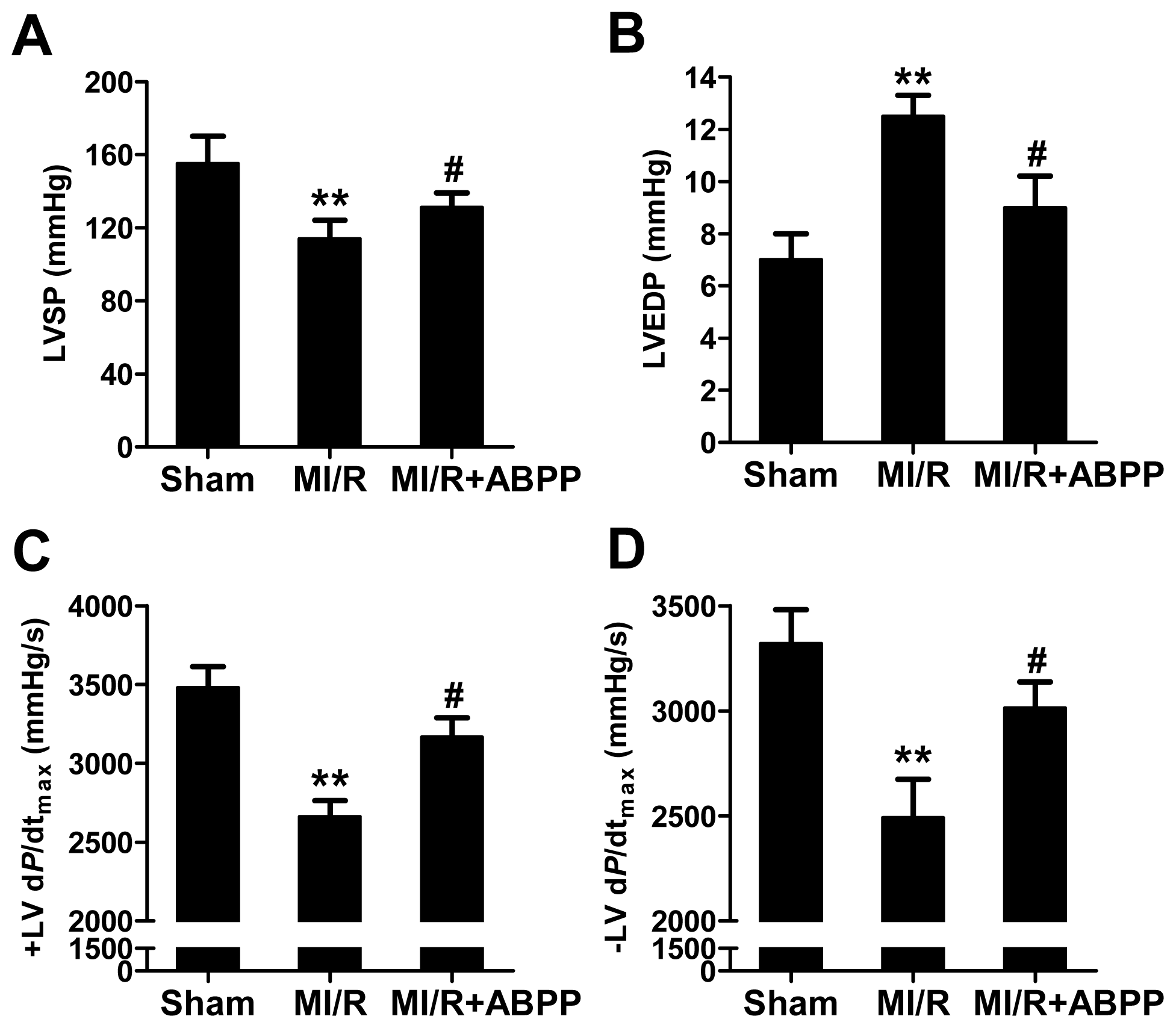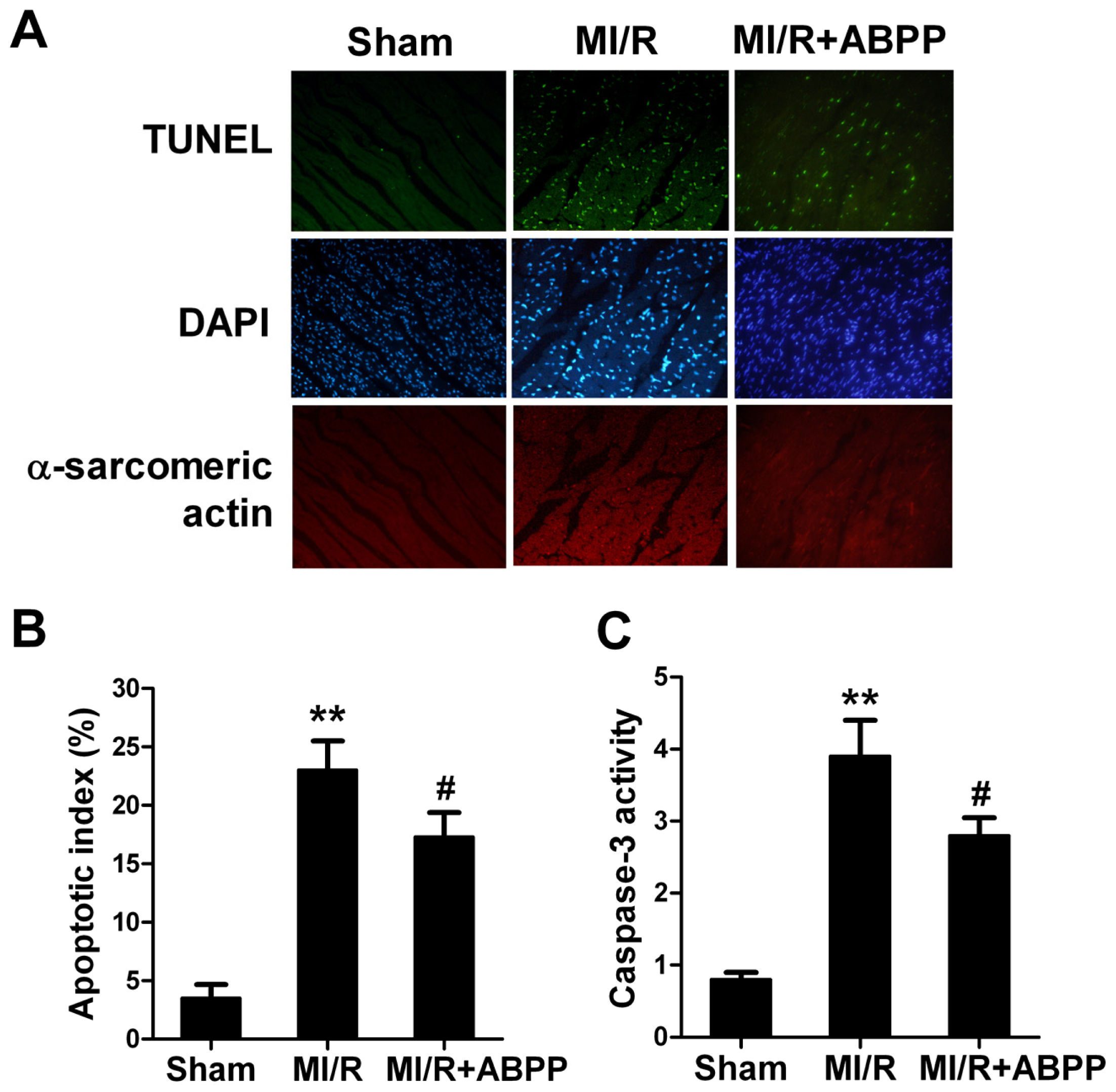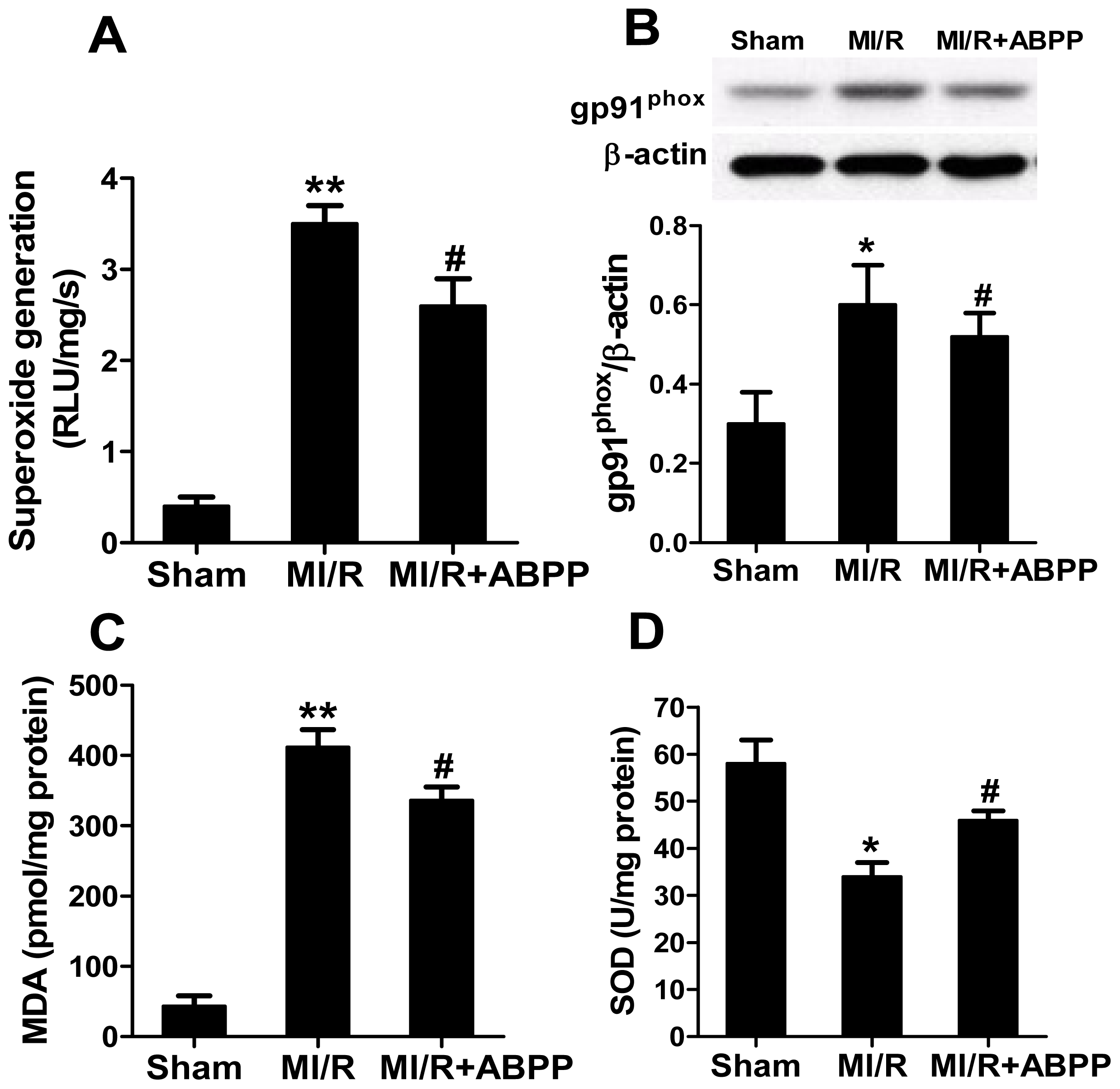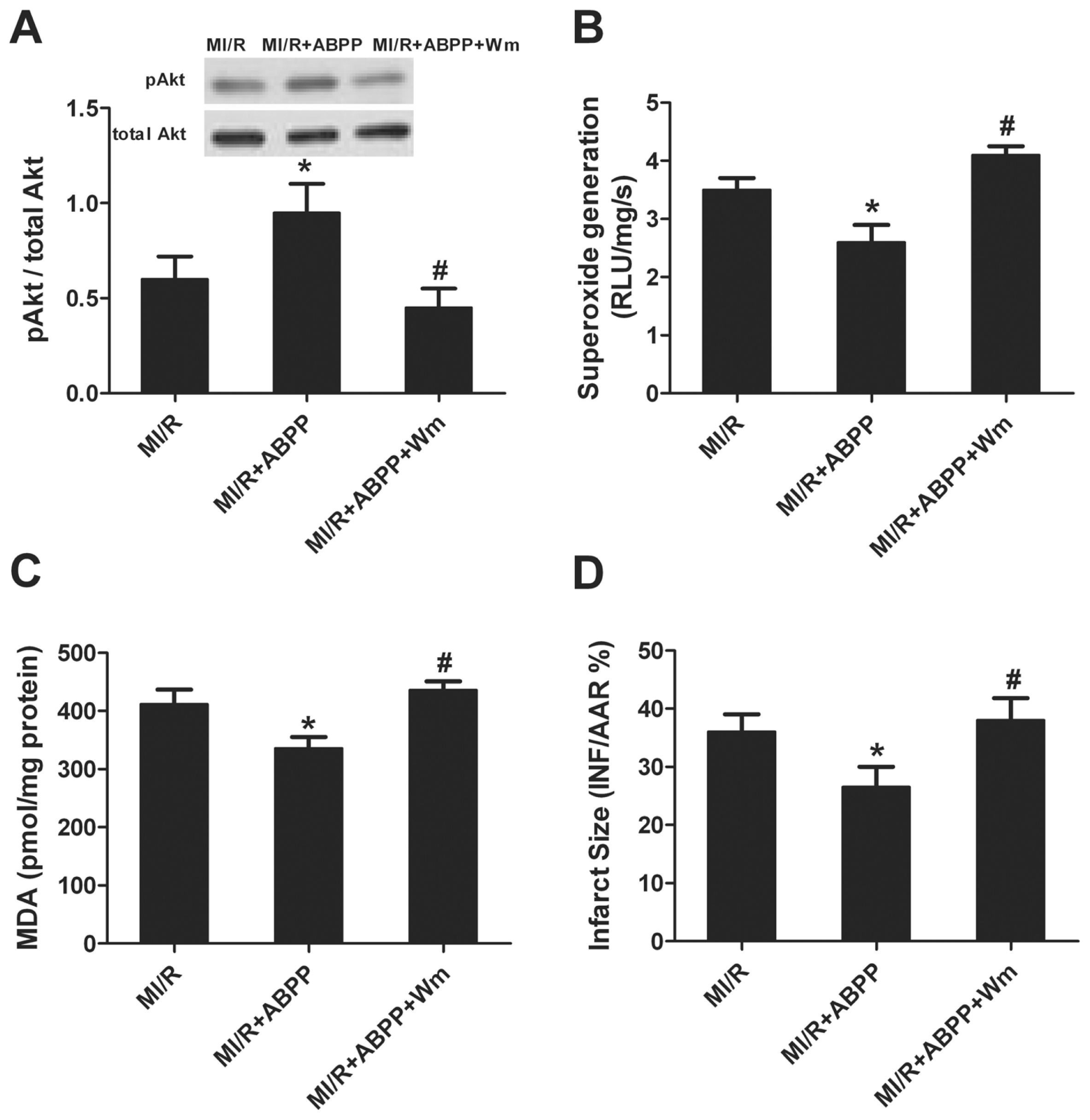Achyranthes bidentata Polypeptides Reduces Oxidative Stress and Exerts Protective Effects against Myocardial Ischemic/Reperfusion Injury in Rats
Abstract
:1. Introduction
2. Results and Discussion
2.1. Achyranthes bidentata Polypeptides Alleviated MI/R-Induced Cardiac Dysfunction
2.2. Achyranthes bidentata Polypeptides Alleviated I/R-Induced Myocardial Injury
2.3. Achyranthes bidentata Polypeptides Decreased Oxidative Stress in I/R Hearts
2.4. Achyranthes bidentata Polypeptides Inhibited PTEN and Activated Akt in I/R Hearts
2.5. Wortmannin Abolished ABPP-Induced Anti-Oxidative Effect and Cardioprotection
2.6. Discussion
3. Experimental Section
3.1. Preparation and Characterization of ABPP
3.2. ABPP Treatment
3.3. Animal Protocols
3.4. Determination of Myocardial Infarction and Apoptosis
3.5. Determination of Plasma Creatine Kinase (CK) and Lactate Dehydrogenase (LDH)
3.6. Quantification of Superoxide Production
3.7. Determination of Tissue Malondialdehyde and Superoxide Dismutase
3.8. Western Blot Analysis
3.9. Statistical Analysis
4. Conclusions






Acknowledgments
Conflicts of Interest
References
- Braunwald, E.; Kloner, R.A. Myocardial reperfusion: A double-edged sword? J. Clin. Invest 1985, 76, 1713–1719. [Google Scholar]
- Ambrosio, G.; Tritto, I. Reperfusion injury: Experimental evidence and clinical implications. Am. Heart J 1999, 138, S69–S75. [Google Scholar]
- Yellon, D.M.; Baxter, G.F. Protecting the ischaemic and reperfused myocardium in acute myocardial infarction: Distant dream or near reality? Heart 2000, 83, 381–387. [Google Scholar]
- Shen, H.; Wu, X.; Zhu, Y.; Sun, H. Intravenous administration of Achyranthes bidentata polypeptides supports recovery from experimental ischemic stroke in vivo. PLoS One 2013, 8, e57055. [Google Scholar]
- Ji, L.; Fu, F.; Zhang, L.; Liu, W.; Cai, X.; Zheng, Q.; Zhang, H.; Gao, F. Insulin attenuates myocardial ischemia/reperfusion injury via reducing oxidative/nitrative stress. Am. J. Physiol. Endocrinol. Metab 2010, 298, E871–880. [Google Scholar]
- Zweier, J.L.; Talukder, M.A. The role of oxidants and free radicals in reperfusion injury. Cardiovasc. Res 2006, 70, 181–190. [Google Scholar]
- Yu, Q.; Gao, F.; Ma, X.L. Insulin says no to cardiovascular disease. Cardiovasc. Res 2011, 89, 516–524. [Google Scholar]
- Kitagishi, Y.; Matsuda, S. Redox regulation of tumor suppressor pten in cancer and aging (Review). Int. J. Mol. Med 2013, 31, 511–515. [Google Scholar]
- Chalhoub, N.; Baker, S.J. Pten and the pi3-kinase pathway in cancer. Annu. Rev. Pathol 2009, 4, 127–150. [Google Scholar]
- Shen, Y.; Zhang, Q.; Gao, X.; Ding, F. An active fraction of Achyranthes bidentata polypeptides prevents apoptosis induced by serum deprivation in sh-sy5y cells through activation of pi3k/akt/gsk3beta pathways. Neurochem. Res 2011, 36, 2186–2194. [Google Scholar]
- Ruan, H.; Li, J.; Ren, S.; Gao, J.; Li, G.; Kim, R.; Wu, H.; Wang, Y. Inducible and cardiac specific pten inactivation protects ischemia/reperfusion injury. J. Mol. Cell. Cardiol 2009, 46, 193–200. [Google Scholar]
- Yuan, Y.; Shen, H.; Yao, J.; Hu, N.; Ding, F.; Gu, X. The protective effects of Achyranthes bidentata polypeptides in an experimental model of mouse sciatic nerve crush injury. Brain. Res. Bull 2010, 81, 25–32. [Google Scholar]
- Ding, F.; Cheng, Q.; Gu, X. The repair effects of Achyranthes bidentata extract on the crushed common peroneal nerve of rabbits. Fitoterapia 2008, 79, 161–167. [Google Scholar]
- Zhou, S.; Chen, X.; Gu, X.; Ding, F. Achyranthes bidentata blume extract protects cultured hippocampal neurons against glutamate-induced neurotoxicity. J. Ethnopharmacol 2009, 122, 547–554. [Google Scholar]
- Wang, Y.; Shen, W.; Yang, L.; Zhao, H.; Gu, W.; Yuan, Y. The protective effects of Achyranthes bidentata polypeptides on rat sciatic nerve crush injury causes modulation of neurotrophic factors. Neurochem. Res 2013, 38, 538–546. [Google Scholar]
- Madamanchi, N.R.; Runge, M.S. Redox signaling in cardiovascular health and disease. Free Radic. Biol. Med 2013, 61C, 473–501. [Google Scholar]
- Kleikers, P.W.; Wingler, K.; Hermans, J.J.; Diebold, I.; Altenhofer, S.; Radermacher, K.A.; Janssen, B.; Gorlach, A.; Schmidt, H.H. Nadph oxidases as a source of oxidative stress and molecular target in ischemia/reperfusion injury. J. Mol. Med 2012, 90, 1391–1406. [Google Scholar]
- Raedschelders, K.; Ansley, D.M.; Chen, D.D. The cellular and molecular origin of reactive oxygen species generation during myocardial ischemia and reperfusion. Pharmacol. Ther 2012, 133, 230–255. [Google Scholar]
- Su, H.; Ji, L.; Xing, W.; Zhang, W.; Zhou, H.; Qian, X.; Wang, X.; Gao, F.; Sun, X.; Zhang, H. Acute hyperglycaemia enhances oxidative stress and aggravates myocardial ischaemia/reperfusion injury: Role of thioredoxin-interacting protein. J. Cell. Mol. Med 2013, 17, 181–191. [Google Scholar]
- Qian, J.; Ling, S.; Castillo, A.C.; Long, B.; Birnbaum, Y.; Ye, Y. Regulation of phosphatase and tensin homolog on chromosome 10 in response to hypoxia. Am. J. Physiol. Heart. Circ. Physiol 2012, 302, H1806–H1817. [Google Scholar]
- Shen, H.; Yuan, Y.; Ding, F.; Liu, J.; Gu, X. The protective effects of Achyranthes bidentata polypeptides against nmda-induced cell apoptosis in cultured hippocampal neurons through differential modulation of nr2a- and nr2b-containing nmda receptors. Brain. Res. Bull 2008, 77, 274–281. [Google Scholar]
- Xing, W.; Yan, W.; Fu, F.; Jin, Y.; Ji, L.; Liu, W.; Wang, L.; Lv, A.; Duan, Y.; Zhang, J.; et al. Insulin inhibits myocardial ischemia-induced apoptosis and alleviates chronic adverse changes in post-ischemic cardiac structure and function. Apoptosis 2009, 14, 1050–1060. [Google Scholar]
- Xie, N.; Zhang, W.; Li, J.; Liang, H.; Zhou, H.; Duan, W.; Xu, X.; Yu, S.; Zhang, H.; Yi, D. A-linolenic acid intake attenuates myocardial ischemia/reperfusion injury through anti-inflammatory and anti-oxidative stress effects in diabetic but not normal rats. Arch. Med. Res 2011, 42, 171–181. [Google Scholar]
© 2013 by the authors; licensee MDPI, Basel, Switzerland This article is an open access article distributed under the terms and conditions of the Creative Commons Attribution license (http://creativecommons.org/licenses/by/3.0/).
Share and Cite
Tie, R.; Ji, L.; Nan, Y.; Wang, W.; Liang, X.; Tian, F.; Xing, W.; Zhu, M.; Li, R.; Zhang, H. Achyranthes bidentata Polypeptides Reduces Oxidative Stress and Exerts Protective Effects against Myocardial Ischemic/Reperfusion Injury in Rats. Int. J. Mol. Sci. 2013, 14, 19792-19804. https://doi.org/10.3390/ijms141019792
Tie R, Ji L, Nan Y, Wang W, Liang X, Tian F, Xing W, Zhu M, Li R, Zhang H. Achyranthes bidentata Polypeptides Reduces Oxidative Stress and Exerts Protective Effects against Myocardial Ischemic/Reperfusion Injury in Rats. International Journal of Molecular Sciences. 2013; 14(10):19792-19804. https://doi.org/10.3390/ijms141019792
Chicago/Turabian StyleTie, Ru, Lele Ji, Ying Nan, Wenqing Wang, Xiangyan Liang, Fei Tian, Wenjuan Xing, Miaozhang Zhu, Rong Li, and Haifeng Zhang. 2013. "Achyranthes bidentata Polypeptides Reduces Oxidative Stress and Exerts Protective Effects against Myocardial Ischemic/Reperfusion Injury in Rats" International Journal of Molecular Sciences 14, no. 10: 19792-19804. https://doi.org/10.3390/ijms141019792



